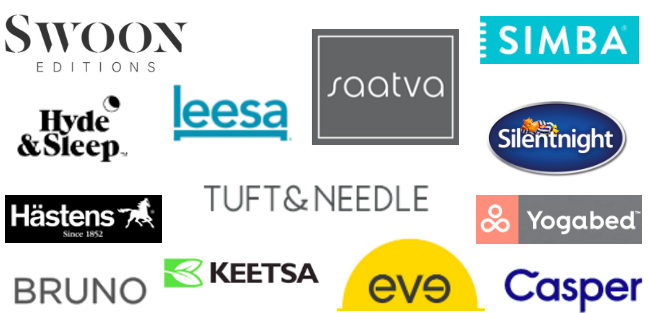How to Choose a Mattress
It’s time-consuming to look for the right bed. There are so many options to consider, as well as numerous variables to consider. Rather than sifting through a large number of mattresses, we have highlighted the models that outperform the competition in their respective categories.
The best mattresses for every budget, build, sleep position, preference, and need are reviewed below. Don’t worry if you just want to see our top picks; we’ve got that, too.
How to Choose a Mattress
When selecting a new mattress, there are several factors to consider. First, in what position do you usually sleep? Back sleepers’ needs differ from those of side sleepers and belly sleepers, which can lead to differences in the best mattress for you. You may also prefer the feel of various materials, such as memory foam or natural materials like latex. You may also sleep hot or cold, share your bed with a partner, or have more specific requirements.
What sleeping position do you prefer?
The parts of the body that require more support to maintain spinal alignment differ depending on your sleeping posture.
- Side – usually awaken on your side.
- Back – usually awaken flat on your back.
- Stomach – usually awaken flat on your stomach.
- Combination – Choose the position that you most often wake up in
What is your weight?
Body shape and weight also influence the selection of the best mattress to provide spinal support, comfort, and other important features.
- under 130 lbs – If your weight is in this range, even a softer mattress may feel firm.
- 130-230 lbs – When deciding on a mattress, weight will play a smaller role.
- over 230 lbs – need more support, so our suggestions will lean toward firmer mattress options.
What is your budget?
Mattress prices range from relatively low-cost, reduced-quality models all the way up to 6-figure designer mattresses. Aside from these exceptions, the majority of mattresses cost between $600 and $2,000.
- looking for a perfect mattress for less than $500.
- want a mattress that costs no more than $1,500.
- gladly spend any amount to find the perfect mattress.
Our best advice is to select a mattress manufacturer that offers a risk-free trial period of at least 30 nights. Why? Because it can take up to three weeks for your body to adjust to a new mattress. We also recommend that you look for a discount before making a purchase.
Top Mattress Brands
Perhaps you’ve seen Casper advertisements on Facebook or YouTube commercials from popular brands like Purple, Saatva, and Nectar. While some of the more successful mattress companies may have a better reputation, we never let brands rest on their past achievements.

How do you know where to begin your search for a mattress when there are so many available online? What about Free Fun Guide’s Top 10 Picks? Each of the following brands provides high-quality mattresses at a reasonable price. From deluxe hybrids to luxurious memory foams, each of the brands listed below has a great mattress for every type of sleeper.
Check out how some of your favorite mattresses fared in our thorough, unbiased mattress reviews.
Comparisons of Top Brands
Having trouble deciding between two mattresses? Do they both appear to be excellent, but you’re looking for something that will tip the scales? We’re here to assist you. We literally put the biggest names in mattresses side by side and break down each component so you know exactly what you’re getting.
- Brooklyn Bedding vs Leesa Mattress Comparison
- Brooklyn Bedding vs Tuft & Needle Mattress Comparison
- Brooklyn Bedding vs GhostBed Comparison
Mattress Types
Gel grids? Latex? Foam? Hybrid? Innerspring? You get the idea – there are many different types of mattresses available. So, which one is ideal for side sleepers? Sleeping beauties? Couples? We break down each mattress’s components so you know exactly who it was designed for.
Memory Foam Mattress
This is the most extensive mattress category. With the advent of roll packing machines that can compress the foam into boxes that could be shipped via UPS, FedEx, or a similar carrier, several of the new startups created a mattress in a box made of layers of glued foam.
- Nest Bedding
- Nectar
- Puffy
- Tuft & Needle
- Lull
- Amerisleep
- Novosbed
- Leesa
- Nuvanna
- Ghostbed
- Loom & Leaf
- Ecosa
- Nolah
- Zoto
- Live and Sleep
- Purple
One distinguishing feature of memory foam is that it allows you to sink into it, which provides above-average cushioning. Such dense material, like any all-foam mattress, can feel warmer at night than other options. Having said that, the best memory foam mattresses now include special cooling materials designed to regulate your body temperature while you sleep.
Luxury Mattress
Mattresses in the Luxury category are more expensive. They may require more labor to make, such as hand tufting, or they may contain more costly materials.
- Brentwood Home
- Dreamcloud
- Puffy
- Lytton
- Wright
- Leesa
Mattresses, like almost everything else, come in a variety of price points. You can expect to pay around $1,500 or more for the best of the best. Special cooling technology, extra durable and supportive construction methods, natural and organic materials, or a combination of all of these features can be found in these beds.
Inner Spring Mattress
Innersprings in the form of pocket coils are typically used in these mattresses. Because they are not roll packed, some are delivered by a freight carrier, but you can buy them online. Hybrid mattresses, which combine memory foam and coils to provide contouring as well as a little bounce, are a growing trend.
- Lytton
- Winkbeds
- Brooklyn Signature
- Nest Bedding
- Yaasa
- Aviya
- Saatva
One significant difference between innerspring mattresses and all-foam options is that innerspring mattresses are buoyant, which means you sleep on top of them rather than sinking into them. That’s great news for hot sleepers because it means your body heat is less likely to be trapped by the mattress, and the springs permit more air circulation than dense foam. Innerspring mattresses have more bounce than all-foam mattresses and can be less expensive.
Foam and Microcoil Mattress
Microcoils contribute to contouring and support in a subtle way. They are becoming more popular in foam mattresses because they allow the mattress to breathe and make it easier to move around in.
- Bear
- Amore Beds
All Natural Mattress
Natural materials such as natural latex, organic cotton covers, and wool fire barriers are used in all natural mattresses. This mattress group includes spring mattresses that use as many natural materials as possible to make the mattress as environmentally friendly as possible.
- Avocado
- Awara
- Happsy
- Birch by Helix
- My Green Mattress
- Winkbeds
- Nest Bedding
- Naturepedic
Mattress under $600
If you’re on a tight budget and looking for a mattress, take a look at the brands listed below. A queen size of these mattresses costs less than $600. These mattresses are of good quality, but they may lack some of the features found in higher-priced models.
- OkiOki
- Zinus
- Brentwood Home
- Nest Bedding
- Allswell
- Modway
- Lucid
This is budget mattress territory, but that doesn’t mean you can’t find a good mattress for less than $600. Many simple foam beds, as well as some low-cost hybrid beds, are priced around this level.
Definitions of Key Mattress Terms
Jargon is something that mattress manufacturers adore. Particular terms and phrases will appear across multiple brands, ranging from motion isolation to reinforced edge support, but what do they all mean? Let’s take it one step at a time…
Adjustable Base Compatibility
The extent to which a mattress can be raised (top, bottom, or both) or bent into an upright position on top of an adjustable bed base.
Antimicrobial Materials
Cotton, fiber, or foam that has been treated to prevent dust mites, bacteria, and fungi from growing.
Certified Organic
Applies to organic and Global Organic Textile Standards (GOTS) certified mattress materials
Coli Springs (Coils)
Spiral-shaped wires that are typically found in the substrate surface of an innerspring or hybrid mattress.
Comfort Layers
These are located at the top of the mattress and are in charge of how comfortable the mattress feels when you start lying on it.
Cushioning Depth
This determines how deeply you sink into the mattress and how well it conforms to your body.
Ease of Repositioning
How well the mattress claims to support you when changing sleeping positions.
Firmness
Used to characterize a mattress’s compression resistance as well as how soft or hard the surface is when lying on it.
Hypoallergenic
Mattresses composed of materials that are less likely to cause allergic reactions. This term appears frequently on natural and organic mattresses.
Motion Isolation
The amount of movement that is felt on each side of the mattress If you sleep in the same bed with a restless sleeper, motion isolation is essential to avoid being disrupted by your partner’s motion.
Off-gassing
The odor that some mattresses emit when they are unboxed This is common, and the odor is caused by chemicals evaporating into the air.
Pressure Relief
This is something that all of the best mattresses provide. Pressure relief refers to how well a mattress relieves pressure points on your body while you sleep. The hips, back, and shoulders are common pressure points. You may experience soreness, loss of circulation, and restlessness as a result of in-bed discomfort if you do not have adequate pressure relief.
Recovery Time
The time it takes for the mattress to return to its original shape after being compressed.
Reinforced Edge Support
Helps to keep your mattress supportive and stable by forming a solid structure around it and allows you to sleep right up to the edge of your mattress Materials such as foam, steel rods, or thick coils are used to provide edge support.
Sagging
Refers to a loss of support or dipping in particular places in the mattress. Sagging is most common in older mattresses.
Warranty
The manufacturer’s policy detailing what it will and will not cover in terms of replacing or repairing the product if faults arise within a certain time frame


